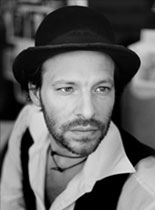
News
Roman Kroke
Interdisciplinary Artist
17 January - 3 February 2020
RESEARCH-TRAVEL: Whale Shark Study with LAMAVE, Pintuyan (Philippines)
For one week I am currently accompanying the scientists of the LAMAVE organisation (Large Marine Vertebrates Research Institute Philippines) at their field site in Pintuyan. My artistic research here is devoted to whale sharks, the largest existing fish on our planet. This experience shall in particular nourish my future artwork BIOUNITY PUZZLE (see below). As their main research tool to study these endangered species, LAMAVE uses so-called “Photo-Identification”. This technique harnesses the uniqueness of the spot pattern on each whale shark’s skin, comparable to a human fingerprint. Through the aid of a star-mapping software, originally used by the Aeronautics and Space Agency NASA, they are able to ‘match’ the animals between areas and thus study their movements. A special thanks to the local project leader of LAMAVE Christine Legaspi and her team to make this unique experience possible.
I am particularly interested in this technique as it resonates with my artistic metaphors on skin patterns – in particular the hexagon motif – which I developed with respect to the topic of plastic pollution of the oceans. See for details my recent publication (2019): online PDF. One of the whale sharks currently identified by LAMAVE also displays a hexagon pattern.
The material which I am currently gathering during the research stay in Pintuyan shall in particular nourish my planned future artwork BIOUNITY PUZZLE, which is planned to be realized throughout the year 2020. By using the HEXAGON as a central metaphor, this future installation will allow me to address a variety of environmental topics from a holistic perspective: Firstly, the current whale shark study will allow me to establish artistic links towards the topic of microplastics, which was the focus of my expedition across the Pacific Ocean on board of the research vessel SONNE from Vancouver (CAN) to Singapore last summer (2019) – belonging to the filter-feeding marine megafauna whale sharks are directly affected by microplastics, see the following article. Thanks to the hexagon-metaphor, the installation will be able to not only address the topic of “plastic pollution” and “marine biodiversity” but also the interrelated larger topics linked to global climate change, such as: the water crisis/desertification (cracks in the parched earth often display hexagon patterns); the unprecedented disappearing of insect populations throughout the last years (in particular honey bees) which has been taken as a sign that our planet is in the midst of a 6th mass extinction (bee hives are formed in hexagon structures).
The title BIOUNITY PUZZLE resonates with this concept: My future artwork shall be composed of numerous free-hanging canvases in hexagon-shape. Each canvas will address a different content and thus illustrate the diversity/complexity of the topic. Comparable to an isolated puzzle piece, each hexagon-panel will originate from a different thematic “home puzzle” (for instance a scientific, philosophical or literary approach towards the topic). In the installation, each hexagon-panel will serve as a representative fragment of its “home topic”. In this context, I also intend to integrate on the canvases traces of the interaction between the different hexagons/topics. Within/despite all this biodiversity and complexity there is also q simple unifying element: in the installation BIOUNITY PUZZLE this shall be expressed through the common hexagon motif. This motif you may find in living beings (humans, animals, plants) as well as in dead matter, in products created by animals or humans (architecture), in different elements (parched earth/sun reflections in the water) etc. This common pattern shall remind us that all elements of our universe are part of a greater whole with fragile independencies which call, last but not least, for a mutual responsibility.
 Facebook
Facebook Google+
Google+ WordPress
WordPress
